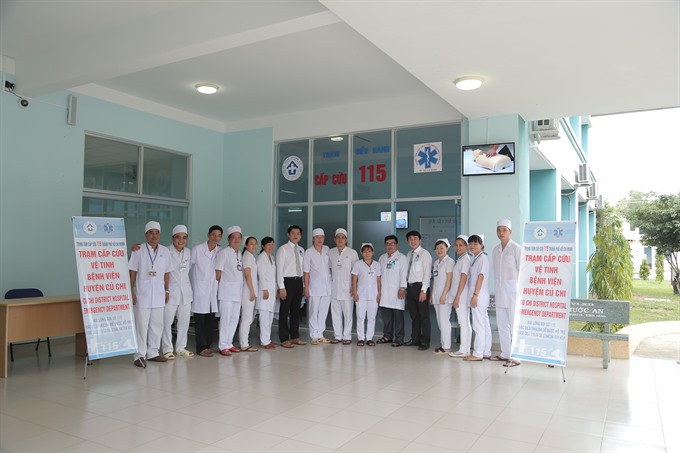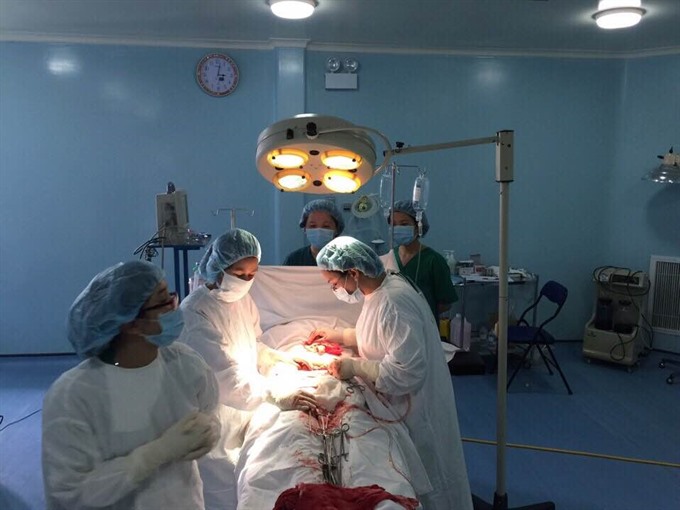 Society
Society

" />When an emergency aid station received a call last year about a woman in a life-threatening situation in HCM City, an ambulance was sent to her home where she was assessed by doctors and later taken to a hospital.
 |
| An emergency aid station at the Củ Chi District hospital, which opened in October last year, has received 125 people so far. — Photo courtesy of Củ Chi District Hospital |
HCM CITY — When an emergency aid station received a call last year about a woman in a life-threatening situation in HCM City, an ambulance was sent to her home where she was assessed by doctors and later taken to a hospital.
The 34-year-old woman who was suffering severe pain caused by a ruptured ectopic pregnancy, was immediately taken to an operating room, where doctors performed emergency surgery, Dr Hồ Hải Trường Giang, head of Củ Chi District Hospital, said via email to Việt Nam News.
The emergency aid station, which is located at the hospital, is one of 25 that exist in the city.
The so-called 115 satellite stations are part of the HCM City Emergency Aid Centre’s network, whose emergency number is 115.
More recently, a 22-year-old victim of a traffic accident was saved by doctors at Củ Chi District Hospital when an emergency aid station’s phone operator received a call from residents who had passed by and noticed the accident.
An ambulance, doctor and nurse immediately went to the scene and gave first aid to the victim, who was then taken to the hospital.
The emergency aid station at the hospital, which opened in October last year, has received 125 people so far, according to Giang.
“The district is large. Putting an emergency aid station in the hospital is vital so we can rapidly assess patients who need emergency aid,” he said.
Before the satellite stations opened at local hospitals, ambulances from the Emergency Aid Centre could not reach Củ Chi District and other outlying areas quickly, especially during peak traffic hours.
All five outlying districts now have access to emergency aid stations, so they can take advantage of the “golden hour”, the time that may be crucial in saving someone’s life, according to the city’s Department of Health.
The latest emergency aid station was set up at Hóc Môn Area General Hospital on October 6 in Hóc Môn District.
 |
| A 34-year-old patient who suffered a ruptured ectopic pregnancy was saved by doctors at the Củ Chi District Hospital after an ambulance was dispatched by a satellite emergency aid station. — Photo courtesy of Củ Chi District Hospital |
Dr Tăng Chí Thượng, deputy head of the city’s Health Department, said red alerts and the emergency aid stations in the inner city and outlying hospitals had improved treatment for severely injured accident victims or patients with serious health problems.
In the red alert procedure, doctors at city- or central-level hospitals are called to provide technical assistance to doctors at other hospitals. If patients need more treatment, they will be transferred to the city or central-level hospitals.
Thượng said the department had asked the Ministry of Education and Training to issue a code for the professional training of paramedics similar to what is used in Australia.
Paramedics would provide out-of-hospital treatment by motorbike, bicycle or speedboat.
The city is studying the use of such vehicles for out-of-hospital emergency services, according to Thượng.
The city also aims to have an intelligent emergency aid system that uses advanced IT. — VNS




